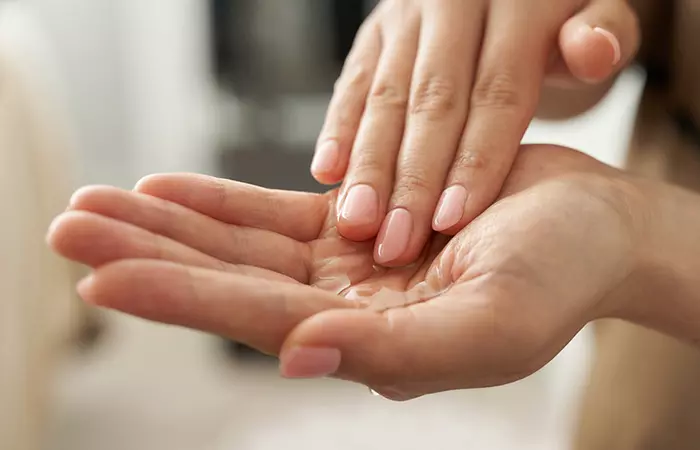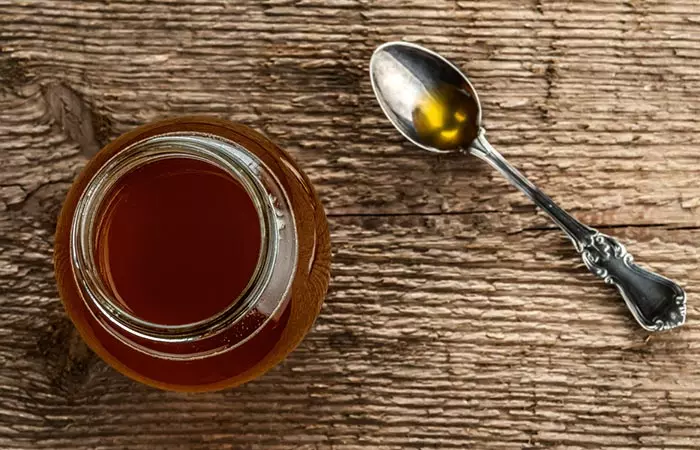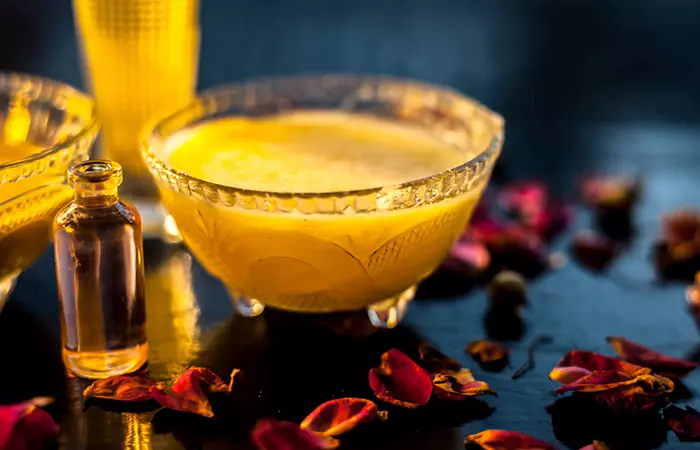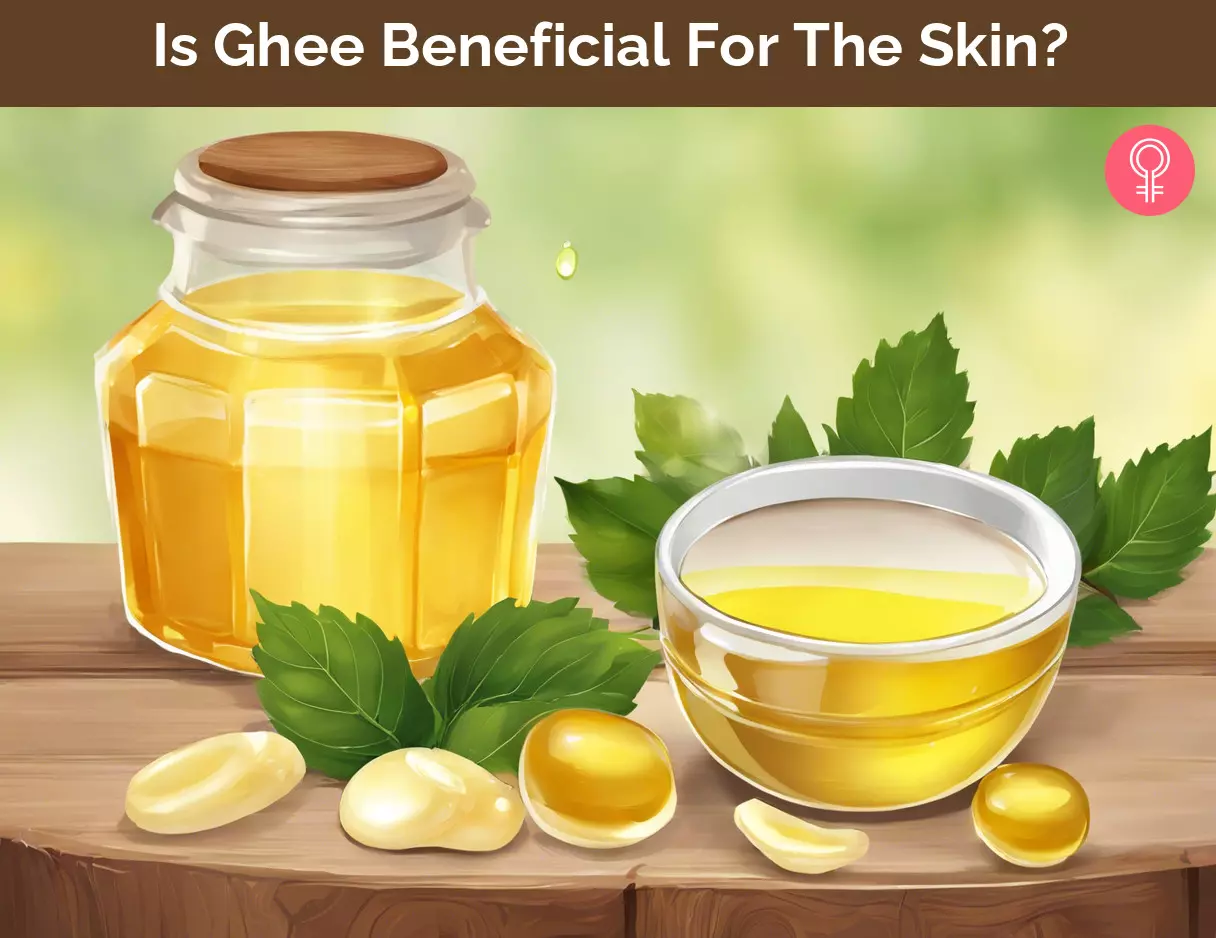If you want to try using ghee for your skin, we can help you with the proper steps. Read this article to know more about how ghee benefits your skin, its use, and its side effects. Scroll down. Who Can Use It? Anyone can use it except people with oily or acne-prone skin, milk allergy, and eczema. How Often? You can apply ghee thrice a week. Caution Excess application may cause clogged pores and increase the risk of fungal infections.
Overgrowth of Malassezia furfur can cause pityriasis versicolor (yeast infection that causes flaky patches) and seborrheic dermatitis (1). If you have oily and acne-prone skin, applying ghee can aggravate the issue. Moreover, it may also clog the skin pores and cause breakouts.
The Benefits Of Ghee For The Skin
Ghee is made up of carotene, butyric acid, omega-3 fatty acids, vitamin A, B12, D, E, and K, and offers the following benefits:
1. May Moisturize The Skin
A study found that ingesting ghee can keep the skin moisturized and reduce erythema (dryness), scaling, and itching associated with dry skin. Another study evaluated the effect of a ghee-based cream and concluded that it could help hydrate the skin (2), (3).
2. Prevents Dark Circles
Anecdotal evidence suggests that ghee’s nourishing and hydrating properties may help maintain the delicate under-eye area and eliminate dark circles.
3. Wound Healing
A study found that a ghee and honey dressing can facilitate wound healing. The dressing has antimicrobial properties and is effective on drug-resistant microbes, promotes healthy tissue growth on the wound, and reduces foul smell, pain, and ulcers (4).
4. Good For Chapped Lips
The phospholipids from ghee help retain moisture in the skin, making ghee beneficial for cracked or dry lips. Deepica Mutyala, a vlogger, spoke about how ghee healed her chapped lips. She said, “3 days of using this and my lips are healed. No cuts (i).” Ghee may be beneficial for the skin when used with different ingredients and as a part of a skin care formulation. There is no scientific proof supporting the benefits of topical ghee application when used alone. All evidence is based on individual experiences. If you are not allergic to milk and want to give this age-old remedy a try, we have some recipes. Scroll down.
How To Use Ghee For Skin
1. Gram Flour And Ghee
Gram flour is used in herbal face masks. It exfoliates the skin, reduces oiliness, and minimizes pimples (5). The lactic acid present in milk may work as a mild exfoliator and stimulate new cell growth (6). What You Will Need
2 tablespoons of ghee 2 tablespoons of gram flour 1 tablespoon of milk
What You Have To Do How Often To Use Use this two times a week.
2. Honey And Ghee
Honey has antioxidant, antimicrobial, and wound-healing properties (7). The antioxidants in it can help fight free radicals, improve skin health, and minimize signs of aging. This face mask can moisturize your skin. What You Will Need
½ tablespoon of ghee ½ tablespoon of honey
What You Have To Do How Often To Use Use it once a day.
3. Turmeric And Ghee
Topical and oral turmeric have therapeutic benefits. It can help soothe skin conditions like atopic dermatitisi A chronic, non-contagious inflammatory condition that causes dry and itchy rashes on the skin. , psoriasisi An autoimmune disorder where the body produces skin cells faster than normal, leading to scaly, itchy, and patchy buildup. , radiodermatitisi Skin rashes and reactions caused by radiation exposure, a common side effect of radiotherapy for cancer treatment. , and photoaging (8). This face mask can soothe and heal your skin and facilitate natural beauty. What You Will Need
1 tablespoon of ghee ½ tablespoon of turmeric powder
What You Have To Do How Often To Use Use it twice a week.
4. Ghee For Dark Circles
Applying ghee can soften and hydrate the delicate under-eye area and improve dark circles. What You Will Need
2-3 drops of ghee
What You Have To Do How Often To Use Use it once a day.
5. Sandalwood Oil And Ghee
Sandalwood oil has antimicrobial and anti-inflammatory properties. It has shown promising results in soothing acne, psoriasis, eczema, and warts (9). Turmeric has therapeutic benefits. When used with ghee, these ingredients can keep your skin healthy. What You Will Need
2-3 drops of sandalwood oil 1 tablespoon of ghee ½ tablespoon of turmeric powder
What You Have To Do How Often To Use Use it 2-3 times a week.
6. Ghee And Coconut oil
Coconut oil has anti-inflammatory properties that help improve skin barrier function and has been shown to help relieve inflammation and redness caused by skin conditions like atopic dermatitis and eczema (10). Ghee and coconut oil moisturize your skin, lending it a visible glow. What You Will Need
1 tablespoon of ghee 1 tablespoon of coconut oil A few drops of any essential oil
What You Have To Do How Often To Use Use it 2-3 times a week. These are a few ways you can use ghee for skin care benefits. However, it is best to avoid ghee if you have any skin conditions or milk allergies. Scroll down to understand how ghee can have adverse effects on your skin.
Disadvantages Of Using Ghee On Your Face
We mentioned earlier that ghee could facilitate an overgrowth of Malassezia furfur on your skin and worsen an existing skin condition. Avoid using ghee if you:
Have eczema, psoriasis, or seborrheic dermatitis. Have oily and acne-prone skin, as ghee may clog the skin pores and cause breakouts. Are allergic to milk.
Using ghee may cause eczema and psoriasis flare-ups and lead to:
Skin rashes Redness Itching and irritation Allergic reactions like hives
Can we apply ghee on our faces every day? Yes, you can apply little amounts of ghee on your face daily to keep your skin supple and healthy. As per anecdotal evidence, ghee benefits for the face include skin brightening and reducing damage from oxidative stress. However, people with oily and acne-prone skin must practice caution while applying ghee on face as it may aggravate acne. Does ghee make lips pink? No, ghee does not make your lips pink. However, the application of ghee can make your lips hydrated and reduce dryness (11). Does ghee have retinol? Yes, ghee is rich in vitamin A, which is used to create retinol. Retinol boosts collagen production and improves the appearance of your skin (12), (13). Does ghee have collagen? Yes, ghee contains vitamin A that is essential in boosting cell growth and collagen production (14).
Illustration: Is Ghee Beneficial For The Skin?
Discover the best Ayurvedic remedies for dry skin. Check out the video to learn how to make a nourishing ghee cream moisturizer to keep your skin hydrated and healthy.












